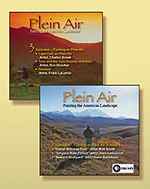![]()
Mid-Atlantic Art: 20-21st Century Northeast and Mid-Atlantic Painting (for years 1997-2000 includes Southeast and Southern American Paintings)


Introduction
This section of the Traditional Fine Arts Organization (TFAO) catalogue Topics in American Art is devoted to the topic "Mid-Atlantic Art: 20-21st Century Northeast and Mid-Atlantic Painting (for years 1997-2000 includes Southeast and Southern American Paintings)." Articles and essays specific to this topic published in TFAO's Resource Library are listed at the beginning of the section.
Following are links to valuable online resources found outside our website. Links may be to museums' articles about exhibits, plus much more topical information based on our online searches.
Following online resources is information about offline resources including museums, DVDs, and paper-printed books, journals and articles.

(above: Jervis McEntee (1828-1891). Mount Desert Island, Maine, 1864, oil on canvas, John Wilmerding Collection. Picture from National Gallery of Art (Washington, D.C.) Source: Wikimedia Commons - public domain*)
Our 452 articles and essays honoring the American experience through its art:
2008-2016 15
2007 13
2006 15
2004- 2005 22
2003 30
2002 33
2001 58
2000 56
1999 94
1998 83
1997 33

(above: Late Summer in Deerfield, MA, 2013. Photo by John Hazeltine)
From other websites:
Art and the New England Farm is a 2018 exhibit at the Florence Griswold Museum which says: "Drawing on the agricultural heritage of Florence Griswold's family estate and of the Lyme region and beyond, this exhibition examines the history and character of New England's farms in works by artists from the 19th to the 21st century." Accessed 6/18
Flora/Fauna: The Naturalist Impulse in American Art is a 2017 exhibit at the Florence Griswold Museum which says: "Drawn extensively from the Museum's collection, as well as many public and private lenders, the 101 works in Flora/Fauna survey the history of environmentally-conscious artists in the United States from the dawn of the 19th century through the mid-20th century." Also see 6/20/17 article in Antiques and The Arts Weekly Accessed 8/17

(above: Mabel May Woodward, New England Summer, Late Afternoon, c. 1920, oil on canvas, 15.9 x 20 inches, Providence Art Club, Providence, Rhode Island.Public domain, via Wikimedia Commons*)
Pastoral Vermont: The Paintings and Etchings of Luigi Lucioni, an exhibit held May 21-August 9, 2009 at the Middlebury College Museum of Art. Includes 10 audio files. Accessed February, 2015.

(above: N. C. Wyeth, Smokey Face, 1917, oil on canvas, 32 1/4 ? 40 inches, Brigham Young University Museum of Art. Public domain, via Wikimedia Commons*)
DVD/VHS videos:
 of Denali, the "Great One,"
North America's tallest mountain. Other episodes feature the Tongass Rain
Forest; Seward, Alaska; Taos, New Mexico; Trinidad, Colorado; and central
Michigan.
of Denali, the "Great One,"
North America's tallest mountain. Other episodes feature the Tongass Rain
Forest; Seward, Alaska; Taos, New Mexico; Trinidad, Colorado; and central
Michigan.

(above, William Aiken Walker, Cotton Wagon, 1893, oil on canvas, 12 x 20 inches, Private Collection, Australia. Public domain, via Wikimedia Commons*)
See our Museums Explained to learn about the "inner workings" of art museums and the functions of staff members. In the exhibitions section find out how to get the most out of a museum visit. See definitions for a glossary of museum-related words used in articles.
To help you plan visits to institutions exhibiting American art when traveling see Sources of Articles Indexed by State within the United States.
Unless otherwise noted, all text and image materials relating to the above institutional source were provided by that source. Before reproducing or transmitting text or images please read Resource Library's user agreement.
Our catalogues provide many more useful resources.
American Representational Art has links to dozens of topics.
Distinguished Artists is a national registry of historic artists.
About Resource Library
Resource Library is a free online publication of nonprofit Traditional Fine Arts Organization (TFAO). Since 1997, Resource Library and its predecessor Resource Library Magazine have cumulatively published online 1,300+ articles and essays written by hundreds of identified authors, thousands of other texts not attributable to named authors, plus 24,000+ images, all providing educational and informational content related to American representational art. Texts and related images are provided almost exclusively by nonprofit art museum, gallery and art center sources.
All published materials provide educational and informational content to students, scholars, teachers and others. Most published materials relate to exhibitions. Materials may include whole exhibition gallery guides, brochures or catalogues or texts from them, perviously published magazine or journal articles, wall panels and object labels, audio tour scripts, play scripts, interviews, blogs, checklists and news releases, plus related images.
What you won't find:
User-tracking cookies are not installed on our website. Privacy of users is very important to us. You won't find annoying banners and pop-ups either. Our pages are loaded blazingly fast. Resource Library contains no advertising and is 100% non-commercial. .
Links to sources of information outside our website are provided only as referrals for your further consideration. Please use due diligence in judging the quality of information contained in these and all other websites. Information from linked sources may be inaccurate or out of date. We neither recommend or endorses these referenced organizations. Although we include links to other websites, we take no responsibility for the content or information contained on other sites, nor exert any editorial or other control over them. For more information on evaluating web pages see our General Resources section in Online Resources for Collectors and Students of Art History.
*Tag for expired US copyright of object image:

 Search Resource Library
Search Resource Library
Copyright 2023 Traditional Fine Arts Organization, Inc., an Arizona nonprofit corporation. All rights reserved.